An Analysis of Critical Issues in Business and 21st Century Leadership
VerifiedAdded on 2020/04/15
|11
|3784
|35
Report
AI Summary
This report provides a comprehensive literature review on 21st-century leadership, exploring critical issues in business and the evolving demands on leaders. It examines the shift from traditional hierarchical structures to more collaborative and adaptive approaches, emphasizing the need for leaders to possess a range of cognitive, interpersonal, and global competencies. The report analyzes key leadership skills such as social intelligence, emotional intelligence, problem-solving abilities, and communication skills, while also considering the importance of managing a diversified workforce. Furthermore, it discusses relevant leadership theories, including charismatic leadership, and highlights the changing trends in leadership styles. The report synthesizes various research findings to offer insights into the challenges and opportunities facing leaders in the modern business landscape.
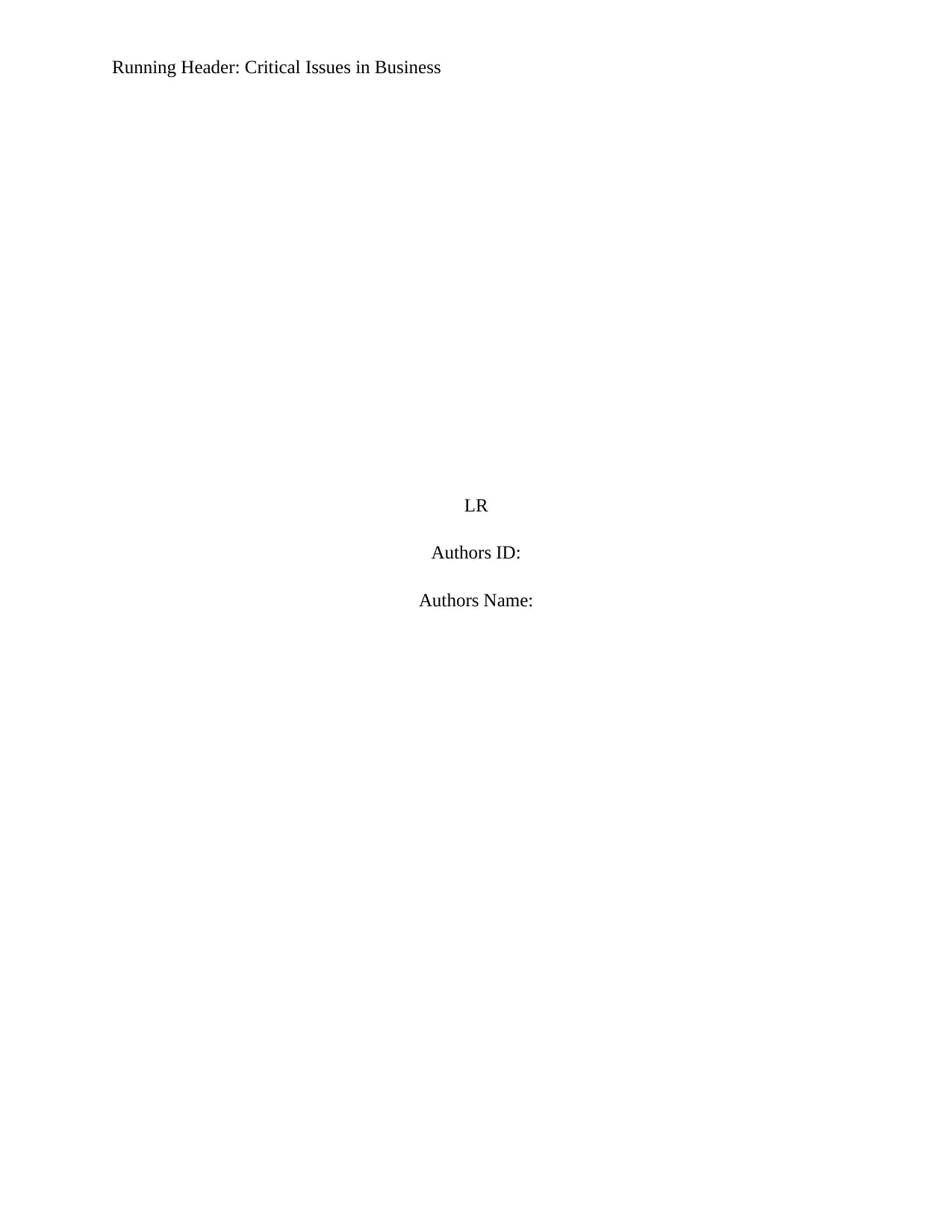
Running Header: Critical Issues in Business
LR
Authors ID:
Authors Name:
LR
Authors ID:
Authors Name:
Paraphrase This Document
Need a fresh take? Get an instant paraphrase of this document with our AI Paraphraser
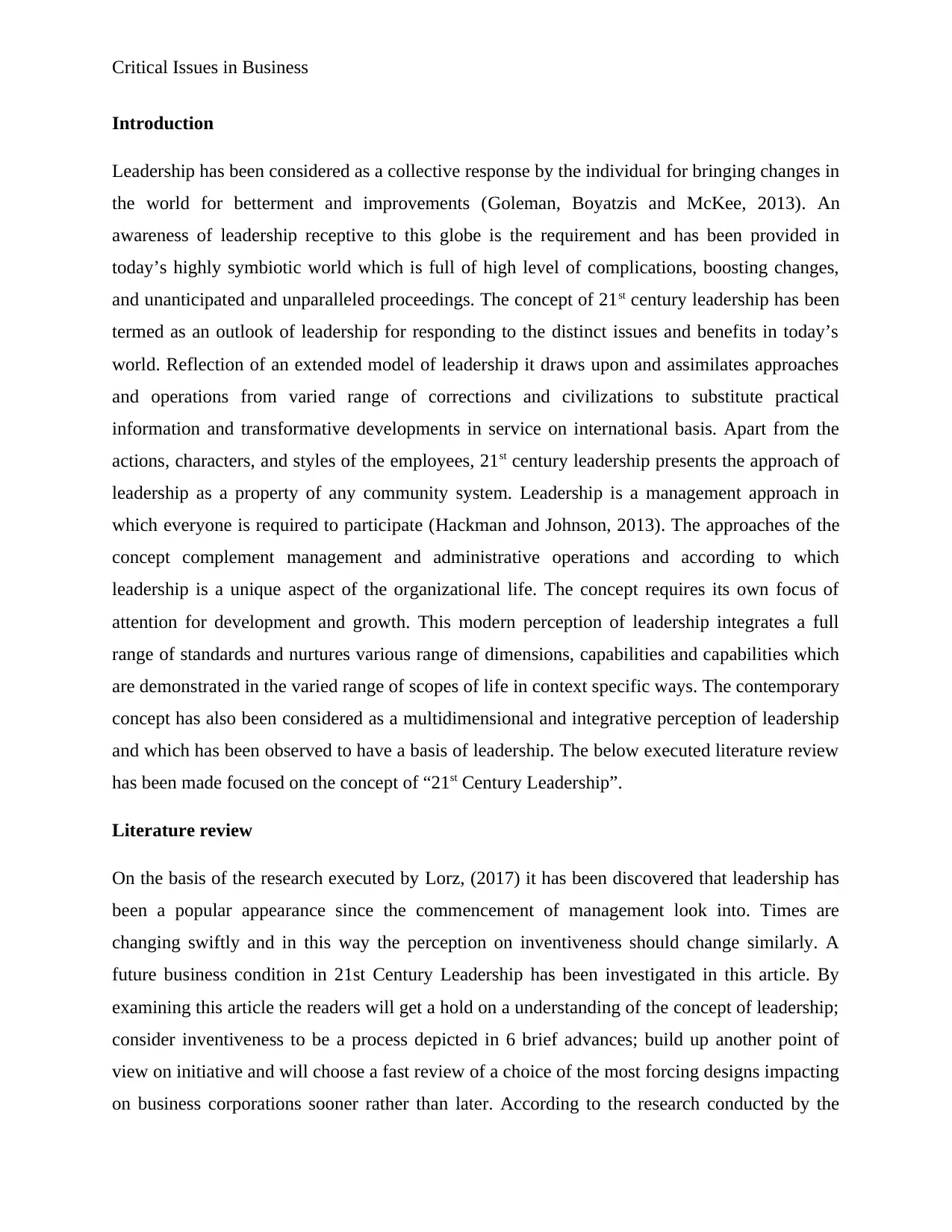
Critical Issues in Business
Introduction
Leadership has been considered as a collective response by the individual for bringing changes in
the world for betterment and improvements (Goleman, Boyatzis and McKee, 2013). An
awareness of leadership receptive to this globe is the requirement and has been provided in
today’s highly symbiotic world which is full of high level of complications, boosting changes,
and unanticipated and unparalleled proceedings. The concept of 21st century leadership has been
termed as an outlook of leadership for responding to the distinct issues and benefits in today’s
world. Reflection of an extended model of leadership it draws upon and assimilates approaches
and operations from varied range of corrections and civilizations to substitute practical
information and transformative developments in service on international basis. Apart from the
actions, characters, and styles of the employees, 21st century leadership presents the approach of
leadership as a property of any community system. Leadership is a management approach in
which everyone is required to participate (Hackman and Johnson, 2013). The approaches of the
concept complement management and administrative operations and according to which
leadership is a unique aspect of the organizational life. The concept requires its own focus of
attention for development and growth. This modern perception of leadership integrates a full
range of standards and nurtures various range of dimensions, capabilities and capabilities which
are demonstrated in the varied range of scopes of life in context specific ways. The contemporary
concept has also been considered as a multidimensional and integrative perception of leadership
and which has been observed to have a basis of leadership. The below executed literature review
has been made focused on the concept of “21st Century Leadership”.
Literature review
On the basis of the research executed by Lorz, (2017) it has been discovered that leadership has
been a popular appearance since the commencement of management look into. Times are
changing swiftly and in this way the perception on inventiveness should change similarly. A
future business condition in 21st Century Leadership has been investigated in this article. By
examining this article the readers will get a hold on a understanding of the concept of leadership;
consider inventiveness to be a process depicted in 6 brief advances; build up another point of
view on initiative and will choose a fast review of a choice of the most forcing designs impacting
on business corporations sooner rather than later. According to the research conducted by the
Introduction
Leadership has been considered as a collective response by the individual for bringing changes in
the world for betterment and improvements (Goleman, Boyatzis and McKee, 2013). An
awareness of leadership receptive to this globe is the requirement and has been provided in
today’s highly symbiotic world which is full of high level of complications, boosting changes,
and unanticipated and unparalleled proceedings. The concept of 21st century leadership has been
termed as an outlook of leadership for responding to the distinct issues and benefits in today’s
world. Reflection of an extended model of leadership it draws upon and assimilates approaches
and operations from varied range of corrections and civilizations to substitute practical
information and transformative developments in service on international basis. Apart from the
actions, characters, and styles of the employees, 21st century leadership presents the approach of
leadership as a property of any community system. Leadership is a management approach in
which everyone is required to participate (Hackman and Johnson, 2013). The approaches of the
concept complement management and administrative operations and according to which
leadership is a unique aspect of the organizational life. The concept requires its own focus of
attention for development and growth. This modern perception of leadership integrates a full
range of standards and nurtures various range of dimensions, capabilities and capabilities which
are demonstrated in the varied range of scopes of life in context specific ways. The contemporary
concept has also been considered as a multidimensional and integrative perception of leadership
and which has been observed to have a basis of leadership. The below executed literature review
has been made focused on the concept of “21st Century Leadership”.
Literature review
On the basis of the research executed by Lorz, (2017) it has been discovered that leadership has
been a popular appearance since the commencement of management look into. Times are
changing swiftly and in this way the perception on inventiveness should change similarly. A
future business condition in 21st Century Leadership has been investigated in this article. By
examining this article the readers will get a hold on a understanding of the concept of leadership;
consider inventiveness to be a process depicted in 6 brief advances; build up another point of
view on initiative and will choose a fast review of a choice of the most forcing designs impacting
on business corporations sooner rather than later. According to the research conducted by the
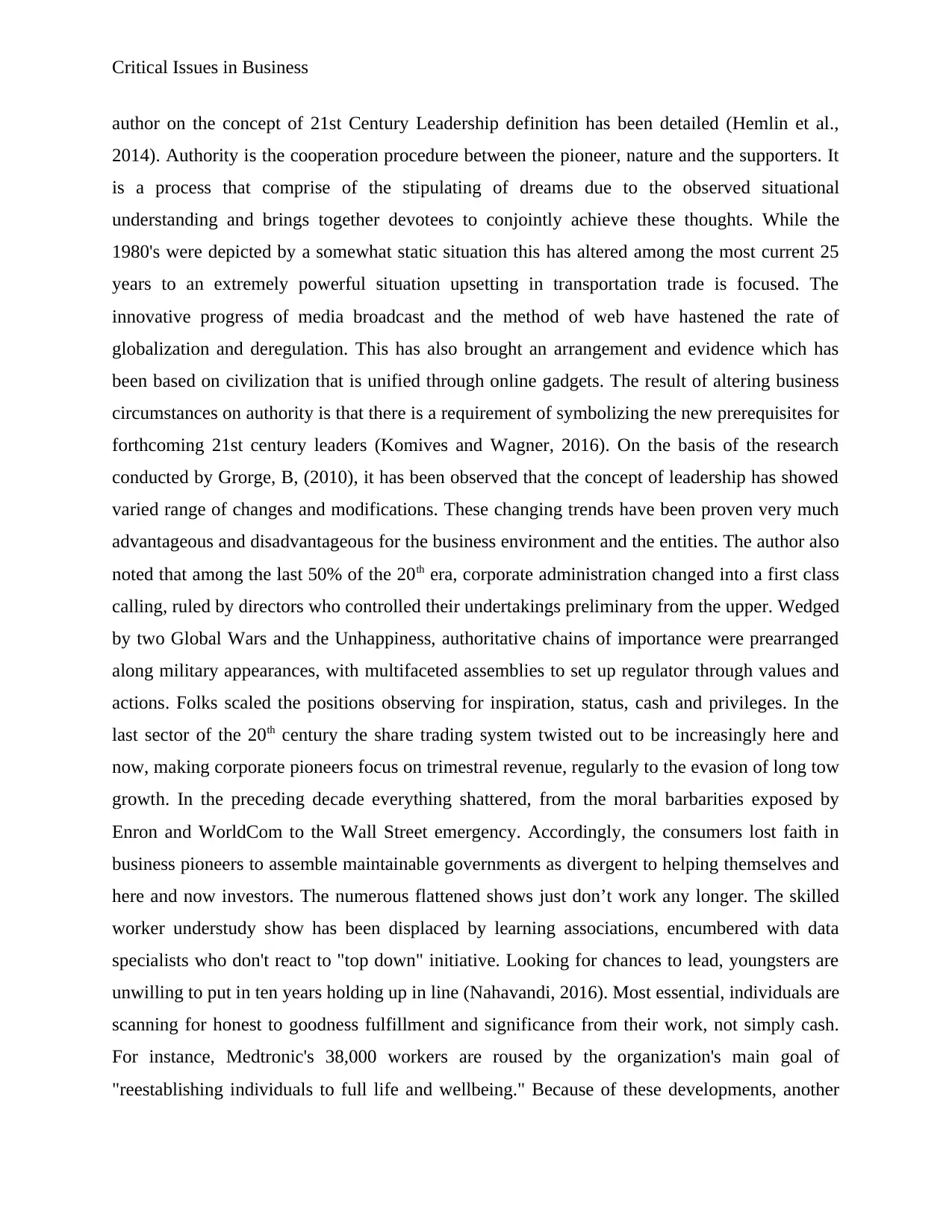
Critical Issues in Business
author on the concept of 21st Century Leadership definition has been detailed (Hemlin et al.,
2014). Authority is the cooperation procedure between the pioneer, nature and the supporters. It
is a process that comprise of the stipulating of dreams due to the observed situational
understanding and brings together devotees to conjointly achieve these thoughts. While the
1980's were depicted by a somewhat static situation this has altered among the most current 25
years to an extremely powerful situation upsetting in transportation trade is focused. The
innovative progress of media broadcast and the method of web have hastened the rate of
globalization and deregulation. This has also brought an arrangement and evidence which has
been based on civilization that is unified through online gadgets. The result of altering business
circumstances on authority is that there is a requirement of symbolizing the new prerequisites for
forthcoming 21st century leaders (Komives and Wagner, 2016). On the basis of the research
conducted by Grorge, B, (2010), it has been observed that the concept of leadership has showed
varied range of changes and modifications. These changing trends have been proven very much
advantageous and disadvantageous for the business environment and the entities. The author also
noted that among the last 50% of the 20th era, corporate administration changed into a first class
calling, ruled by directors who controlled their undertakings preliminary from the upper. Wedged
by two Global Wars and the Unhappiness, authoritative chains of importance were prearranged
along military appearances, with multifaceted assemblies to set up regulator through values and
actions. Folks scaled the positions observing for inspiration, status, cash and privileges. In the
last sector of the 20th century the share trading system twisted out to be increasingly here and
now, making corporate pioneers focus on trimestral revenue, regularly to the evasion of long tow
growth. In the preceding decade everything shattered, from the moral barbarities exposed by
Enron and WorldCom to the Wall Street emergency. Accordingly, the consumers lost faith in
business pioneers to assemble maintainable governments as divergent to helping themselves and
here and now investors. The numerous flattened shows just don’t work any longer. The skilled
worker understudy show has been displaced by learning associations, encumbered with data
specialists who don't react to "top down" initiative. Looking for chances to lead, youngsters are
unwilling to put in ten years holding up in line (Nahavandi, 2016). Most essential, individuals are
scanning for honest to goodness fulfillment and significance from their work, not simply cash.
For instance, Medtronic's 38,000 workers are roused by the organization's main goal of
"reestablishing individuals to full life and wellbeing." Because of these developments, another
author on the concept of 21st Century Leadership definition has been detailed (Hemlin et al.,
2014). Authority is the cooperation procedure between the pioneer, nature and the supporters. It
is a process that comprise of the stipulating of dreams due to the observed situational
understanding and brings together devotees to conjointly achieve these thoughts. While the
1980's were depicted by a somewhat static situation this has altered among the most current 25
years to an extremely powerful situation upsetting in transportation trade is focused. The
innovative progress of media broadcast and the method of web have hastened the rate of
globalization and deregulation. This has also brought an arrangement and evidence which has
been based on civilization that is unified through online gadgets. The result of altering business
circumstances on authority is that there is a requirement of symbolizing the new prerequisites for
forthcoming 21st century leaders (Komives and Wagner, 2016). On the basis of the research
conducted by Grorge, B, (2010), it has been observed that the concept of leadership has showed
varied range of changes and modifications. These changing trends have been proven very much
advantageous and disadvantageous for the business environment and the entities. The author also
noted that among the last 50% of the 20th era, corporate administration changed into a first class
calling, ruled by directors who controlled their undertakings preliminary from the upper. Wedged
by two Global Wars and the Unhappiness, authoritative chains of importance were prearranged
along military appearances, with multifaceted assemblies to set up regulator through values and
actions. Folks scaled the positions observing for inspiration, status, cash and privileges. In the
last sector of the 20th century the share trading system twisted out to be increasingly here and
now, making corporate pioneers focus on trimestral revenue, regularly to the evasion of long tow
growth. In the preceding decade everything shattered, from the moral barbarities exposed by
Enron and WorldCom to the Wall Street emergency. Accordingly, the consumers lost faith in
business pioneers to assemble maintainable governments as divergent to helping themselves and
here and now investors. The numerous flattened shows just don’t work any longer. The skilled
worker understudy show has been displaced by learning associations, encumbered with data
specialists who don't react to "top down" initiative. Looking for chances to lead, youngsters are
unwilling to put in ten years holding up in line (Nahavandi, 2016). Most essential, individuals are
scanning for honest to goodness fulfillment and significance from their work, not simply cash.
For instance, Medtronic's 38,000 workers are roused by the organization's main goal of
"reestablishing individuals to full life and wellbeing." Because of these developments, another
⊘ This is a preview!⊘
Do you want full access?
Subscribe today to unlock all pages.

Trusted by 1+ million students worldwide
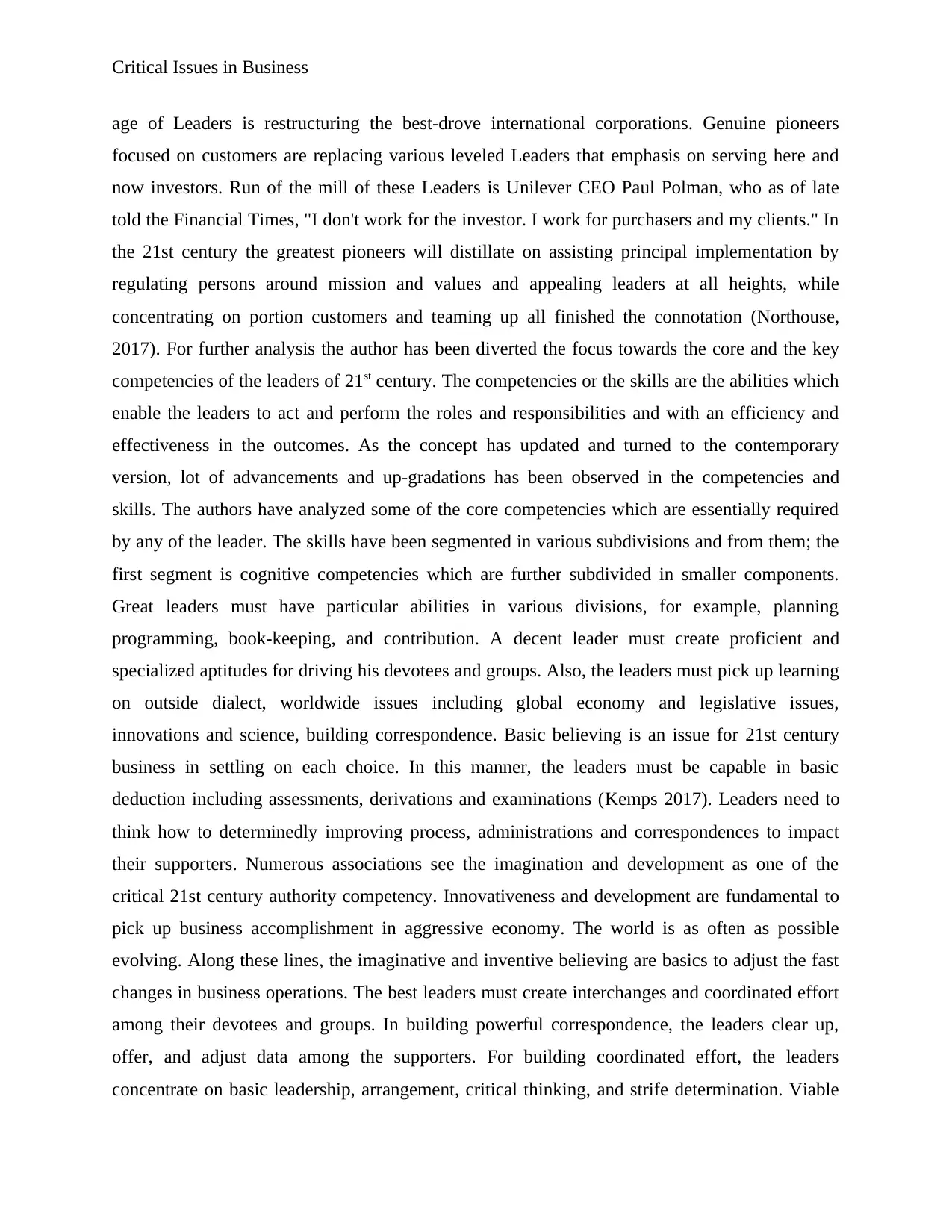
Critical Issues in Business
age of Leaders is restructuring the best-drove international corporations. Genuine pioneers
focused on customers are replacing various leveled Leaders that emphasis on serving here and
now investors. Run of the mill of these Leaders is Unilever CEO Paul Polman, who as of late
told the Financial Times, "I don't work for the investor. I work for purchasers and my clients." In
the 21st century the greatest pioneers will distillate on assisting principal implementation by
regulating persons around mission and values and appealing leaders at all heights, while
concentrating on portion customers and teaming up all finished the connotation (Northouse,
2017). For further analysis the author has been diverted the focus towards the core and the key
competencies of the leaders of 21st century. The competencies or the skills are the abilities which
enable the leaders to act and perform the roles and responsibilities and with an efficiency and
effectiveness in the outcomes. As the concept has updated and turned to the contemporary
version, lot of advancements and up-gradations has been observed in the competencies and
skills. The authors have analyzed some of the core competencies which are essentially required
by any of the leader. The skills have been segmented in various subdivisions and from them; the
first segment is cognitive competencies which are further subdivided in smaller components.
Great leaders must have particular abilities in various divisions, for example, planning
programming, book-keeping, and contribution. A decent leader must create proficient and
specialized aptitudes for driving his devotees and groups. Also, the leaders must pick up learning
on outside dialect, worldwide issues including global economy and legislative issues,
innovations and science, building correspondence. Basic believing is an issue for 21st century
business in settling on each choice. In this manner, the leaders must be capable in basic
deduction including assessments, derivations and examinations (Kemps 2017). Leaders need to
think how to determinedly improving process, administrations and correspondences to impact
their supporters. Numerous associations see the imagination and development as one of the
critical 21st century authority competency. Innovativeness and development are fundamental to
pick up business accomplishment in aggressive economy. The world is as often as possible
evolving. Along these lines, the imaginative and inventive believing are basics to adjust the fast
changes in business operations. The best leaders must create interchanges and coordinated effort
among their devotees and groups. In building powerful correspondence, the leaders clear up,
offer, and adjust data among the supporters. For building coordinated effort, the leaders
concentrate on basic leadership, arrangement, critical thinking, and strife determination. Viable
age of Leaders is restructuring the best-drove international corporations. Genuine pioneers
focused on customers are replacing various leveled Leaders that emphasis on serving here and
now investors. Run of the mill of these Leaders is Unilever CEO Paul Polman, who as of late
told the Financial Times, "I don't work for the investor. I work for purchasers and my clients." In
the 21st century the greatest pioneers will distillate on assisting principal implementation by
regulating persons around mission and values and appealing leaders at all heights, while
concentrating on portion customers and teaming up all finished the connotation (Northouse,
2017). For further analysis the author has been diverted the focus towards the core and the key
competencies of the leaders of 21st century. The competencies or the skills are the abilities which
enable the leaders to act and perform the roles and responsibilities and with an efficiency and
effectiveness in the outcomes. As the concept has updated and turned to the contemporary
version, lot of advancements and up-gradations has been observed in the competencies and
skills. The authors have analyzed some of the core competencies which are essentially required
by any of the leader. The skills have been segmented in various subdivisions and from them; the
first segment is cognitive competencies which are further subdivided in smaller components.
Great leaders must have particular abilities in various divisions, for example, planning
programming, book-keeping, and contribution. A decent leader must create proficient and
specialized aptitudes for driving his devotees and groups. Also, the leaders must pick up learning
on outside dialect, worldwide issues including global economy and legislative issues,
innovations and science, building correspondence. Basic believing is an issue for 21st century
business in settling on each choice. In this manner, the leaders must be capable in basic
deduction including assessments, derivations and examinations (Kemps 2017). Leaders need to
think how to determinedly improving process, administrations and correspondences to impact
their supporters. Numerous associations see the imagination and development as one of the
critical 21st century authority competency. Innovativeness and development are fundamental to
pick up business accomplishment in aggressive economy. The world is as often as possible
evolving. Along these lines, the imaginative and inventive believing are basics to adjust the fast
changes in business operations. The best leaders must create interchanges and coordinated effort
among their devotees and groups. In building powerful correspondence, the leaders clear up,
offer, and adjust data among the supporters. For building coordinated effort, the leaders
concentrate on basic leadership, arrangement, critical thinking, and strife determination. Viable
Paraphrase This Document
Need a fresh take? Get an instant paraphrase of this document with our AI Paraphraser
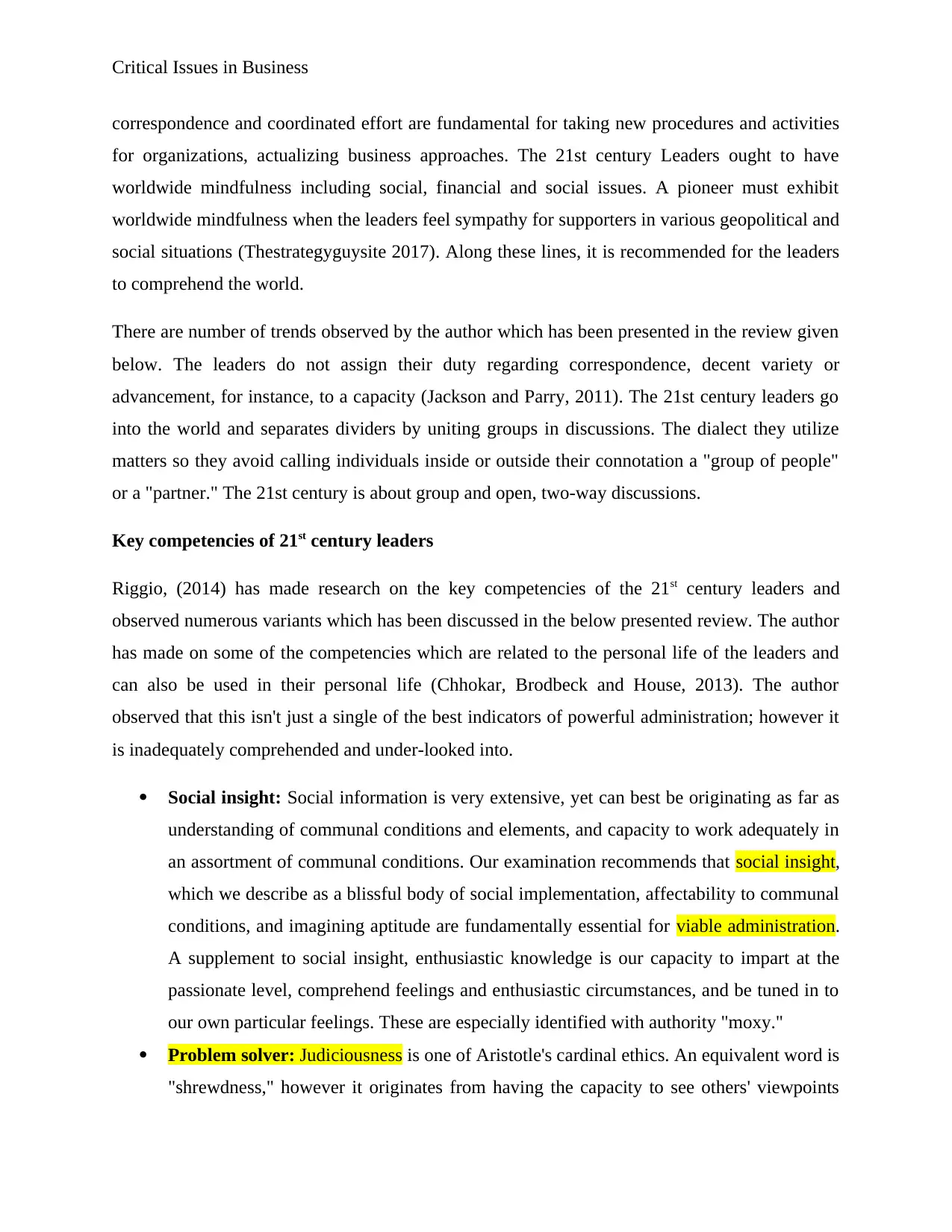
Critical Issues in Business
correspondence and coordinated effort are fundamental for taking new procedures and activities
for organizations, actualizing business approaches. The 21st century Leaders ought to have
worldwide mindfulness including social, financial and social issues. A pioneer must exhibit
worldwide mindfulness when the leaders feel sympathy for supporters in various geopolitical and
social situations (Thestrategyguysite 2017). Along these lines, it is recommended for the leaders
to comprehend the world.
There are number of trends observed by the author which has been presented in the review given
below. The leaders do not assign their duty regarding correspondence, decent variety or
advancement, for instance, to a capacity (Jackson and Parry, 2011). The 21st century leaders go
into the world and separates dividers by uniting groups in discussions. The dialect they utilize
matters so they avoid calling individuals inside or outside their connotation a "group of people"
or a "partner." The 21st century is about group and open, two-way discussions.
Key competencies of 21st century leaders
Riggio, (2014) has made research on the key competencies of the 21st century leaders and
observed numerous variants which has been discussed in the below presented review. The author
has made on some of the competencies which are related to the personal life of the leaders and
can also be used in their personal life (Chhokar, Brodbeck and House, 2013). The author
observed that this isn't just a single of the best indicators of powerful administration; however it
is inadequately comprehended and under-looked into.
Social insight: Social information is very extensive, yet can best be originating as far as
understanding of communal conditions and elements, and capacity to work adequately in
an assortment of communal conditions. Our examination recommends that social insight,
which we describe as a blissful body of social implementation, affectability to communal
conditions, and imagining aptitude are fundamentally essential for viable administration.
A supplement to social insight, enthusiastic knowledge is our capacity to impart at the
passionate level, comprehend feelings and enthusiastic circumstances, and be tuned in to
our own particular feelings. These are especially identified with authority "moxy."
Problem solver: Judiciousness is one of Aristotle's cardinal ethics. An equivalent word is
"shrewdness," however it originates from having the capacity to see others' viewpoints
correspondence and coordinated effort are fundamental for taking new procedures and activities
for organizations, actualizing business approaches. The 21st century Leaders ought to have
worldwide mindfulness including social, financial and social issues. A pioneer must exhibit
worldwide mindfulness when the leaders feel sympathy for supporters in various geopolitical and
social situations (Thestrategyguysite 2017). Along these lines, it is recommended for the leaders
to comprehend the world.
There are number of trends observed by the author which has been presented in the review given
below. The leaders do not assign their duty regarding correspondence, decent variety or
advancement, for instance, to a capacity (Jackson and Parry, 2011). The 21st century leaders go
into the world and separates dividers by uniting groups in discussions. The dialect they utilize
matters so they avoid calling individuals inside or outside their connotation a "group of people"
or a "partner." The 21st century is about group and open, two-way discussions.
Key competencies of 21st century leaders
Riggio, (2014) has made research on the key competencies of the 21st century leaders and
observed numerous variants which has been discussed in the below presented review. The author
has made on some of the competencies which are related to the personal life of the leaders and
can also be used in their personal life (Chhokar, Brodbeck and House, 2013). The author
observed that this isn't just a single of the best indicators of powerful administration; however it
is inadequately comprehended and under-looked into.
Social insight: Social information is very extensive, yet can best be originating as far as
understanding of communal conditions and elements, and capacity to work adequately in
an assortment of communal conditions. Our examination recommends that social insight,
which we describe as a blissful body of social implementation, affectability to communal
conditions, and imagining aptitude are fundamentally essential for viable administration.
A supplement to social insight, enthusiastic knowledge is our capacity to impart at the
passionate level, comprehend feelings and enthusiastic circumstances, and be tuned in to
our own particular feelings. These are especially identified with authority "moxy."
Problem solver: Judiciousness is one of Aristotle's cardinal ethics. An equivalent word is
"shrewdness," however it originates from having the capacity to see others' viewpoints
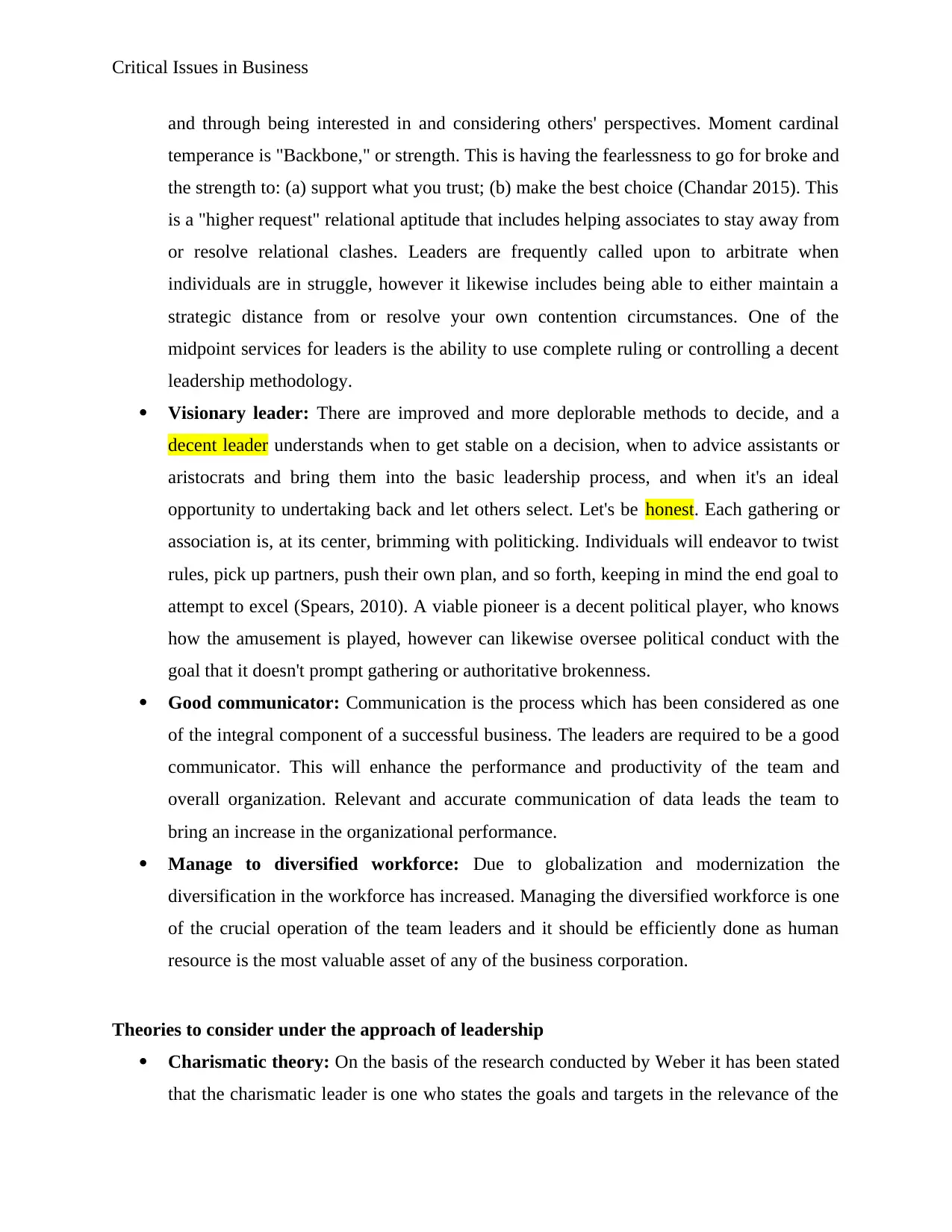
Critical Issues in Business
and through being interested in and considering others' perspectives. Moment cardinal
temperance is "Backbone," or strength. This is having the fearlessness to go for broke and
the strength to: (a) support what you trust; (b) make the best choice (Chandar 2015). This
is a "higher request" relational aptitude that includes helping associates to stay away from
or resolve relational clashes. Leaders are frequently called upon to arbitrate when
individuals are in struggle, however it likewise includes being able to either maintain a
strategic distance from or resolve your own contention circumstances. One of the
midpoint services for leaders is the ability to use complete ruling or controlling a decent
leadership methodology.
Visionary leader: There are improved and more deplorable methods to decide, and a
decent leader understands when to get stable on a decision, when to advice assistants or
aristocrats and bring them into the basic leadership process, and when it's an ideal
opportunity to undertaking back and let others select. Let's be honest. Each gathering or
association is, at its center, brimming with politicking. Individuals will endeavor to twist
rules, pick up partners, push their own plan, and so forth, keeping in mind the end goal to
attempt to excel (Spears, 2010). A viable pioneer is a decent political player, who knows
how the amusement is played, however can likewise oversee political conduct with the
goal that it doesn't prompt gathering or authoritative brokenness.
Good communicator: Communication is the process which has been considered as one
of the integral component of a successful business. The leaders are required to be a good
communicator. This will enhance the performance and productivity of the team and
overall organization. Relevant and accurate communication of data leads the team to
bring an increase in the organizational performance.
Manage to diversified workforce: Due to globalization and modernization the
diversification in the workforce has increased. Managing the diversified workforce is one
of the crucial operation of the team leaders and it should be efficiently done as human
resource is the most valuable asset of any of the business corporation.
Theories to consider under the approach of leadership
Charismatic theory: On the basis of the research conducted by Weber it has been stated
that the charismatic leader is one who states the goals and targets in the relevance of the
and through being interested in and considering others' perspectives. Moment cardinal
temperance is "Backbone," or strength. This is having the fearlessness to go for broke and
the strength to: (a) support what you trust; (b) make the best choice (Chandar 2015). This
is a "higher request" relational aptitude that includes helping associates to stay away from
or resolve relational clashes. Leaders are frequently called upon to arbitrate when
individuals are in struggle, however it likewise includes being able to either maintain a
strategic distance from or resolve your own contention circumstances. One of the
midpoint services for leaders is the ability to use complete ruling or controlling a decent
leadership methodology.
Visionary leader: There are improved and more deplorable methods to decide, and a
decent leader understands when to get stable on a decision, when to advice assistants or
aristocrats and bring them into the basic leadership process, and when it's an ideal
opportunity to undertaking back and let others select. Let's be honest. Each gathering or
association is, at its center, brimming with politicking. Individuals will endeavor to twist
rules, pick up partners, push their own plan, and so forth, keeping in mind the end goal to
attempt to excel (Spears, 2010). A viable pioneer is a decent political player, who knows
how the amusement is played, however can likewise oversee political conduct with the
goal that it doesn't prompt gathering or authoritative brokenness.
Good communicator: Communication is the process which has been considered as one
of the integral component of a successful business. The leaders are required to be a good
communicator. This will enhance the performance and productivity of the team and
overall organization. Relevant and accurate communication of data leads the team to
bring an increase in the organizational performance.
Manage to diversified workforce: Due to globalization and modernization the
diversification in the workforce has increased. Managing the diversified workforce is one
of the crucial operation of the team leaders and it should be efficiently done as human
resource is the most valuable asset of any of the business corporation.
Theories to consider under the approach of leadership
Charismatic theory: On the basis of the research conducted by Weber it has been stated
that the charismatic leader is one who states the goals and targets in the relevance of the
⊘ This is a preview!⊘
Do you want full access?
Subscribe today to unlock all pages.

Trusted by 1+ million students worldwide
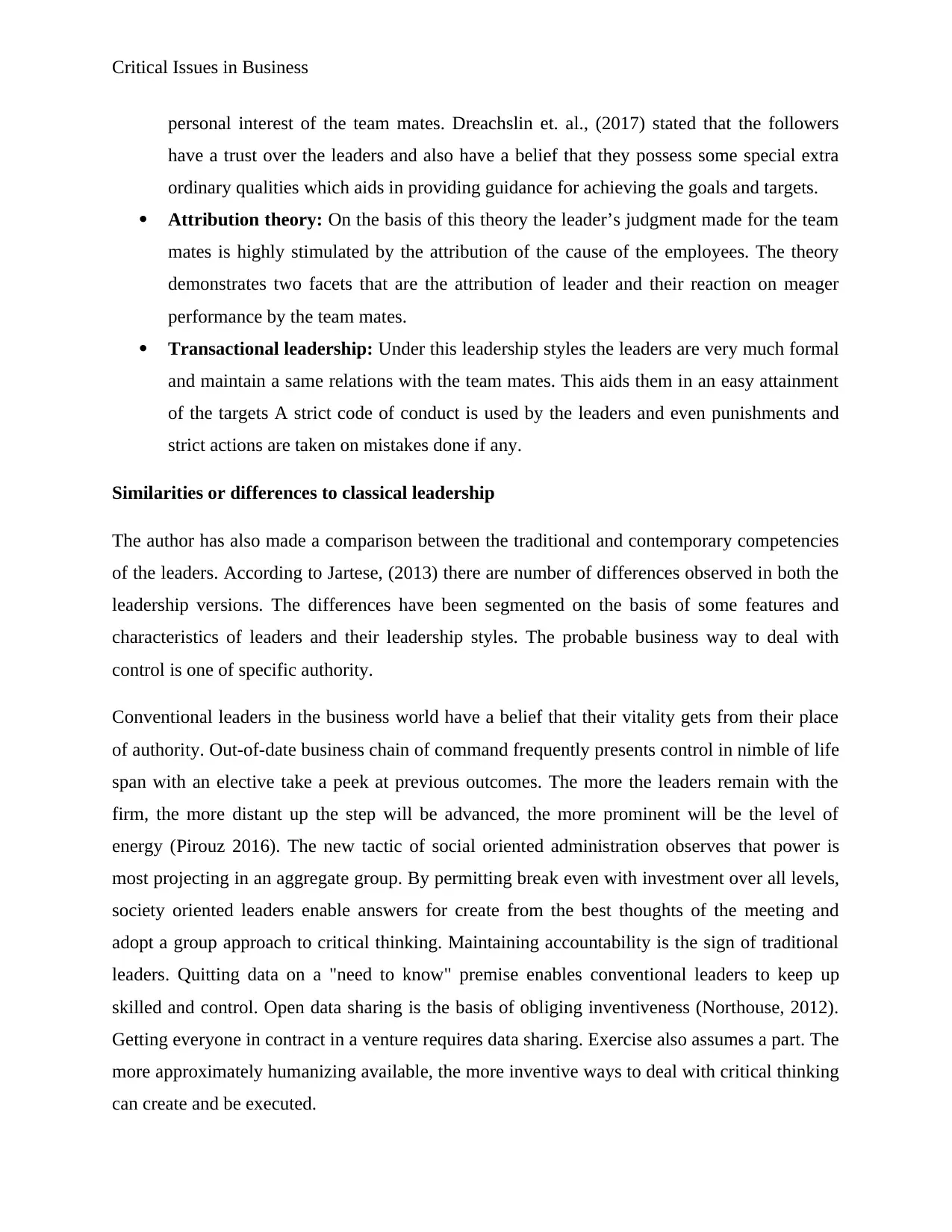
Critical Issues in Business
personal interest of the team mates. Dreachslin et. al., (2017) stated that the followers
have a trust over the leaders and also have a belief that they possess some special extra
ordinary qualities which aids in providing guidance for achieving the goals and targets.
Attribution theory: On the basis of this theory the leader’s judgment made for the team
mates is highly stimulated by the attribution of the cause of the employees. The theory
demonstrates two facets that are the attribution of leader and their reaction on meager
performance by the team mates.
Transactional leadership: Under this leadership styles the leaders are very much formal
and maintain a same relations with the team mates. This aids them in an easy attainment
of the targets A strict code of conduct is used by the leaders and even punishments and
strict actions are taken on mistakes done if any.
Similarities or differences to classical leadership
The author has also made a comparison between the traditional and contemporary competencies
of the leaders. According to Jartese, (2013) there are number of differences observed in both the
leadership versions. The differences have been segmented on the basis of some features and
characteristics of leaders and their leadership styles. The probable business way to deal with
control is one of specific authority.
Conventional leaders in the business world have a belief that their vitality gets from their place
of authority. Out-of-date business chain of command frequently presents control in nimble of life
span with an elective take a peek at previous outcomes. The more the leaders remain with the
firm, the more distant up the step will be advanced, the more prominent will be the level of
energy (Pirouz 2016). The new tactic of social oriented administration observes that power is
most projecting in an aggregate group. By permitting break even with investment over all levels,
society oriented leaders enable answers for create from the best thoughts of the meeting and
adopt a group approach to critical thinking. Maintaining accountability is the sign of traditional
leaders. Quitting data on a "need to know" premise enables conventional leaders to keep up
skilled and control. Open data sharing is the basis of obliging inventiveness (Northouse, 2012).
Getting everyone in contract in a venture requires data sharing. Exercise also assumes a part. The
more approximately humanizing available, the more inventive ways to deal with critical thinking
can create and be executed.
personal interest of the team mates. Dreachslin et. al., (2017) stated that the followers
have a trust over the leaders and also have a belief that they possess some special extra
ordinary qualities which aids in providing guidance for achieving the goals and targets.
Attribution theory: On the basis of this theory the leader’s judgment made for the team
mates is highly stimulated by the attribution of the cause of the employees. The theory
demonstrates two facets that are the attribution of leader and their reaction on meager
performance by the team mates.
Transactional leadership: Under this leadership styles the leaders are very much formal
and maintain a same relations with the team mates. This aids them in an easy attainment
of the targets A strict code of conduct is used by the leaders and even punishments and
strict actions are taken on mistakes done if any.
Similarities or differences to classical leadership
The author has also made a comparison between the traditional and contemporary competencies
of the leaders. According to Jartese, (2013) there are number of differences observed in both the
leadership versions. The differences have been segmented on the basis of some features and
characteristics of leaders and their leadership styles. The probable business way to deal with
control is one of specific authority.
Conventional leaders in the business world have a belief that their vitality gets from their place
of authority. Out-of-date business chain of command frequently presents control in nimble of life
span with an elective take a peek at previous outcomes. The more the leaders remain with the
firm, the more distant up the step will be advanced, the more prominent will be the level of
energy (Pirouz 2016). The new tactic of social oriented administration observes that power is
most projecting in an aggregate group. By permitting break even with investment over all levels,
society oriented leaders enable answers for create from the best thoughts of the meeting and
adopt a group approach to critical thinking. Maintaining accountability is the sign of traditional
leaders. Quitting data on a "need to know" premise enables conventional leaders to keep up
skilled and control. Open data sharing is the basis of obliging inventiveness (Northouse, 2012).
Getting everyone in contract in a venture requires data sharing. Exercise also assumes a part. The
more approximately humanizing available, the more inventive ways to deal with critical thinking
can create and be executed.
Paraphrase This Document
Need a fresh take? Get an instant paraphrase of this document with our AI Paraphraser
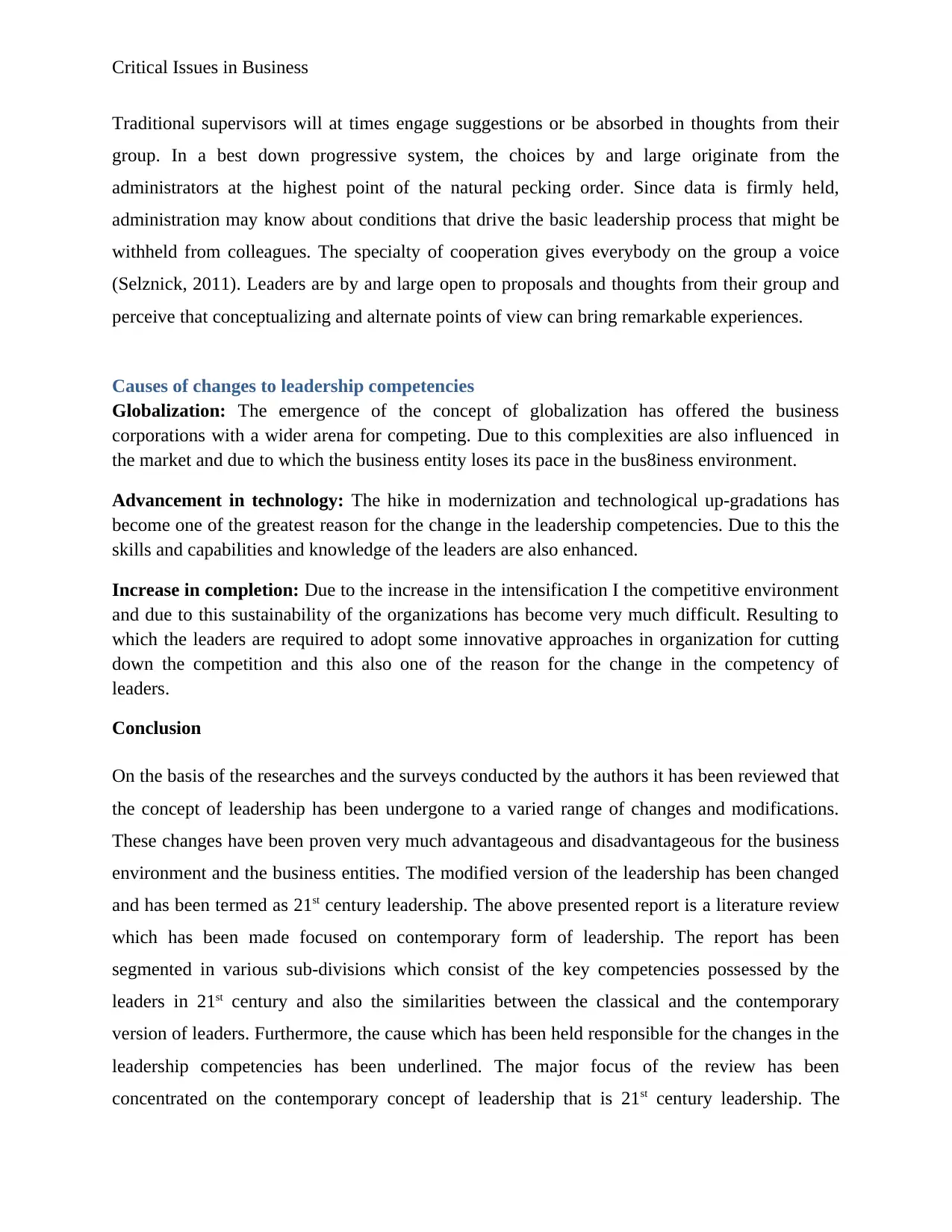
Critical Issues in Business
Traditional supervisors will at times engage suggestions or be absorbed in thoughts from their
group. In a best down progressive system, the choices by and large originate from the
administrators at the highest point of the natural pecking order. Since data is firmly held,
administration may know about conditions that drive the basic leadership process that might be
withheld from colleagues. The specialty of cooperation gives everybody on the group a voice
(Selznick, 2011). Leaders are by and large open to proposals and thoughts from their group and
perceive that conceptualizing and alternate points of view can bring remarkable experiences.
Causes of changes to leadership competencies
Globalization: The emergence of the concept of globalization has offered the business
corporations with a wider arena for competing. Due to this complexities are also influenced in
the market and due to which the business entity loses its pace in the bus8iness environment.
Advancement in technology: The hike in modernization and technological up-gradations has
become one of the greatest reason for the change in the leadership competencies. Due to this the
skills and capabilities and knowledge of the leaders are also enhanced.
Increase in completion: Due to the increase in the intensification I the competitive environment
and due to this sustainability of the organizations has become very much difficult. Resulting to
which the leaders are required to adopt some innovative approaches in organization for cutting
down the competition and this also one of the reason for the change in the competency of
leaders.
Conclusion
On the basis of the researches and the surveys conducted by the authors it has been reviewed that
the concept of leadership has been undergone to a varied range of changes and modifications.
These changes have been proven very much advantageous and disadvantageous for the business
environment and the business entities. The modified version of the leadership has been changed
and has been termed as 21st century leadership. The above presented report is a literature review
which has been made focused on contemporary form of leadership. The report has been
segmented in various sub-divisions which consist of the key competencies possessed by the
leaders in 21st century and also the similarities between the classical and the contemporary
version of leaders. Furthermore, the cause which has been held responsible for the changes in the
leadership competencies has been underlined. The major focus of the review has been
concentrated on the contemporary concept of leadership that is 21st century leadership. The
Traditional supervisors will at times engage suggestions or be absorbed in thoughts from their
group. In a best down progressive system, the choices by and large originate from the
administrators at the highest point of the natural pecking order. Since data is firmly held,
administration may know about conditions that drive the basic leadership process that might be
withheld from colleagues. The specialty of cooperation gives everybody on the group a voice
(Selznick, 2011). Leaders are by and large open to proposals and thoughts from their group and
perceive that conceptualizing and alternate points of view can bring remarkable experiences.
Causes of changes to leadership competencies
Globalization: The emergence of the concept of globalization has offered the business
corporations with a wider arena for competing. Due to this complexities are also influenced in
the market and due to which the business entity loses its pace in the bus8iness environment.
Advancement in technology: The hike in modernization and technological up-gradations has
become one of the greatest reason for the change in the leadership competencies. Due to this the
skills and capabilities and knowledge of the leaders are also enhanced.
Increase in completion: Due to the increase in the intensification I the competitive environment
and due to this sustainability of the organizations has become very much difficult. Resulting to
which the leaders are required to adopt some innovative approaches in organization for cutting
down the competition and this also one of the reason for the change in the competency of
leaders.
Conclusion
On the basis of the researches and the surveys conducted by the authors it has been reviewed that
the concept of leadership has been undergone to a varied range of changes and modifications.
These changes have been proven very much advantageous and disadvantageous for the business
environment and the business entities. The modified version of the leadership has been changed
and has been termed as 21st century leadership. The above presented report is a literature review
which has been made focused on contemporary form of leadership. The report has been
segmented in various sub-divisions which consist of the key competencies possessed by the
leaders in 21st century and also the similarities between the classical and the contemporary
version of leaders. Furthermore, the cause which has been held responsible for the changes in the
leadership competencies has been underlined. The major focus of the review has been
concentrated on the contemporary concept of leadership that is 21st century leadership. The
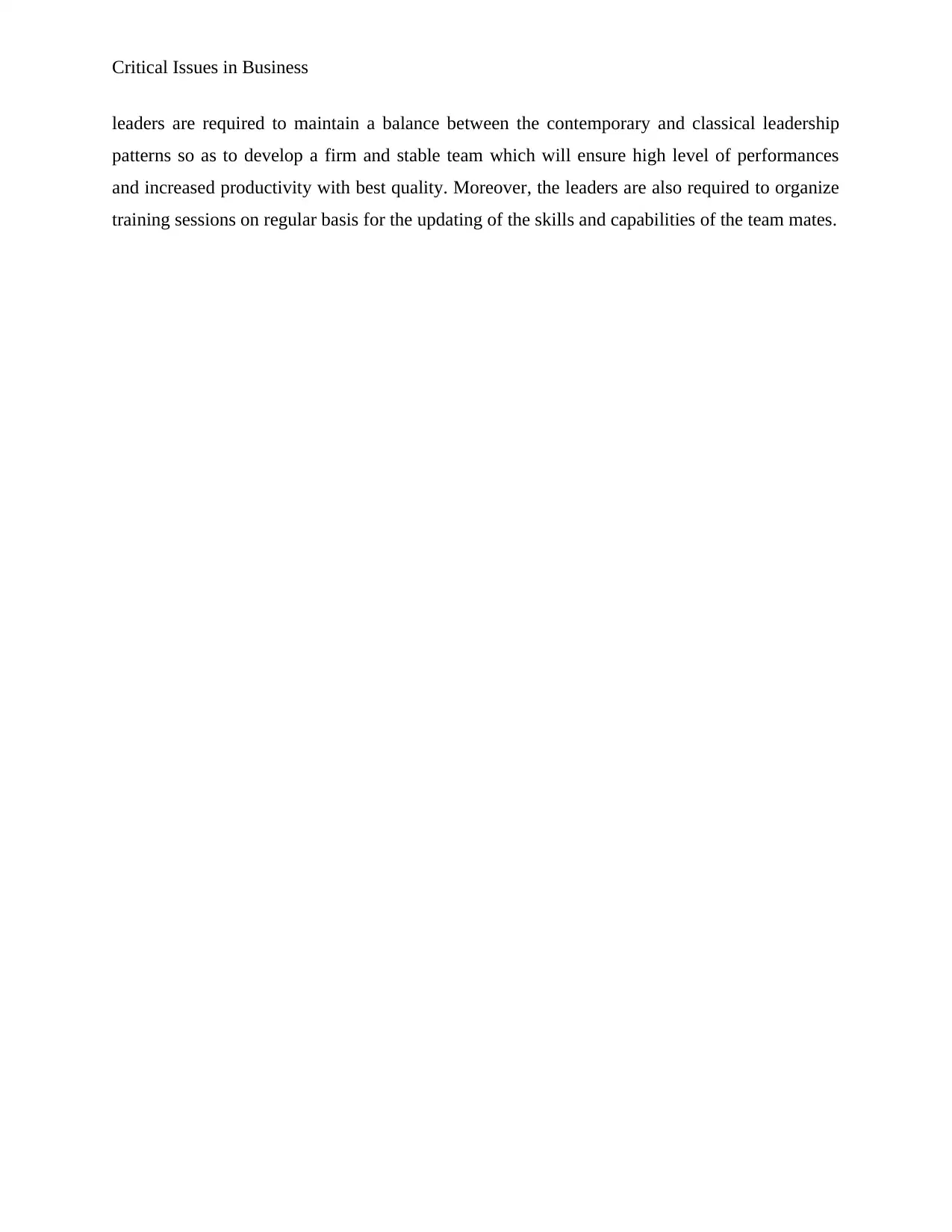
Critical Issues in Business
leaders are required to maintain a balance between the contemporary and classical leadership
patterns so as to develop a firm and stable team which will ensure high level of performances
and increased productivity with best quality. Moreover, the leaders are also required to organize
training sessions on regular basis for the updating of the skills and capabilities of the team mates.
leaders are required to maintain a balance between the contemporary and classical leadership
patterns so as to develop a firm and stable team which will ensure high level of performances
and increased productivity with best quality. Moreover, the leaders are also required to organize
training sessions on regular basis for the updating of the skills and capabilities of the team mates.
⊘ This is a preview!⊘
Do you want full access?
Subscribe today to unlock all pages.

Trusted by 1+ million students worldwide
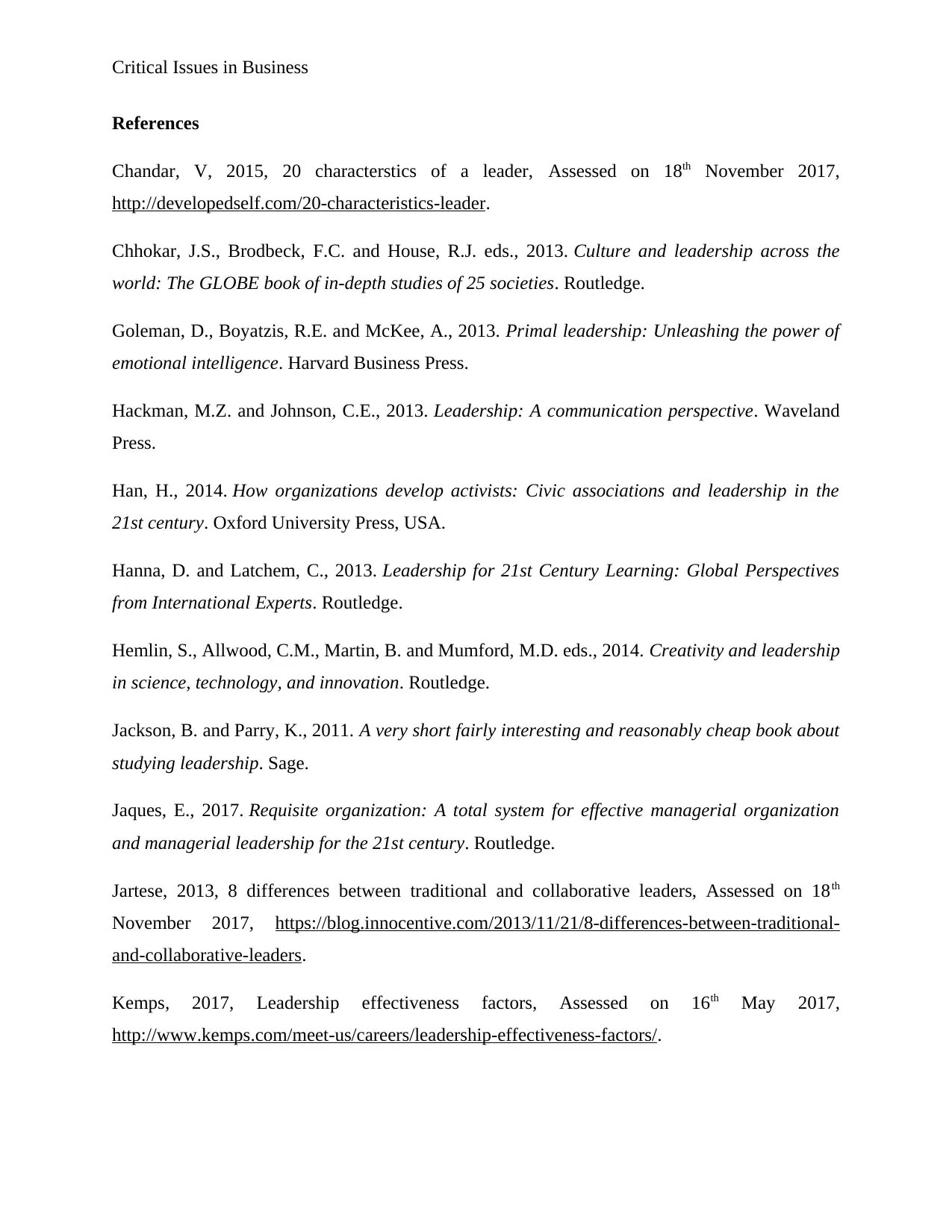
Critical Issues in Business
References
Chandar, V, 2015, 20 characterstics of a leader, Assessed on 18th November 2017,
http://developedself.com/20-characteristics-leader.
Chhokar, J.S., Brodbeck, F.C. and House, R.J. eds., 2013. Culture and leadership across the
world: The GLOBE book of in-depth studies of 25 societies. Routledge.
Goleman, D., Boyatzis, R.E. and McKee, A., 2013. Primal leadership: Unleashing the power of
emotional intelligence. Harvard Business Press.
Hackman, M.Z. and Johnson, C.E., 2013. Leadership: A communication perspective. Waveland
Press.
Han, H., 2014. How organizations develop activists: Civic associations and leadership in the
21st century. Oxford University Press, USA.
Hanna, D. and Latchem, C., 2013. Leadership for 21st Century Learning: Global Perspectives
from International Experts. Routledge.
Hemlin, S., Allwood, C.M., Martin, B. and Mumford, M.D. eds., 2014. Creativity and leadership
in science, technology, and innovation. Routledge.
Jackson, B. and Parry, K., 2011. A very short fairly interesting and reasonably cheap book about
studying leadership. Sage.
Jaques, E., 2017. Requisite organization: A total system for effective managerial organization
and managerial leadership for the 21st century. Routledge.
Jartese, 2013, 8 differences between traditional and collaborative leaders, Assessed on 18th
November 2017, https://blog.innocentive.com/2013/11/21/8-differences-between-traditional-
and-collaborative-leaders.
Kemps, 2017, Leadership effectiveness factors, Assessed on 16th May 2017,
http://www.kemps.com/meet-us/careers/leadership-effectiveness-factors/.
References
Chandar, V, 2015, 20 characterstics of a leader, Assessed on 18th November 2017,
http://developedself.com/20-characteristics-leader.
Chhokar, J.S., Brodbeck, F.C. and House, R.J. eds., 2013. Culture and leadership across the
world: The GLOBE book of in-depth studies of 25 societies. Routledge.
Goleman, D., Boyatzis, R.E. and McKee, A., 2013. Primal leadership: Unleashing the power of
emotional intelligence. Harvard Business Press.
Hackman, M.Z. and Johnson, C.E., 2013. Leadership: A communication perspective. Waveland
Press.
Han, H., 2014. How organizations develop activists: Civic associations and leadership in the
21st century. Oxford University Press, USA.
Hanna, D. and Latchem, C., 2013. Leadership for 21st Century Learning: Global Perspectives
from International Experts. Routledge.
Hemlin, S., Allwood, C.M., Martin, B. and Mumford, M.D. eds., 2014. Creativity and leadership
in science, technology, and innovation. Routledge.
Jackson, B. and Parry, K., 2011. A very short fairly interesting and reasonably cheap book about
studying leadership. Sage.
Jaques, E., 2017. Requisite organization: A total system for effective managerial organization
and managerial leadership for the 21st century. Routledge.
Jartese, 2013, 8 differences between traditional and collaborative leaders, Assessed on 18th
November 2017, https://blog.innocentive.com/2013/11/21/8-differences-between-traditional-
and-collaborative-leaders.
Kemps, 2017, Leadership effectiveness factors, Assessed on 16th May 2017,
http://www.kemps.com/meet-us/careers/leadership-effectiveness-factors/.
Paraphrase This Document
Need a fresh take? Get an instant paraphrase of this document with our AI Paraphraser
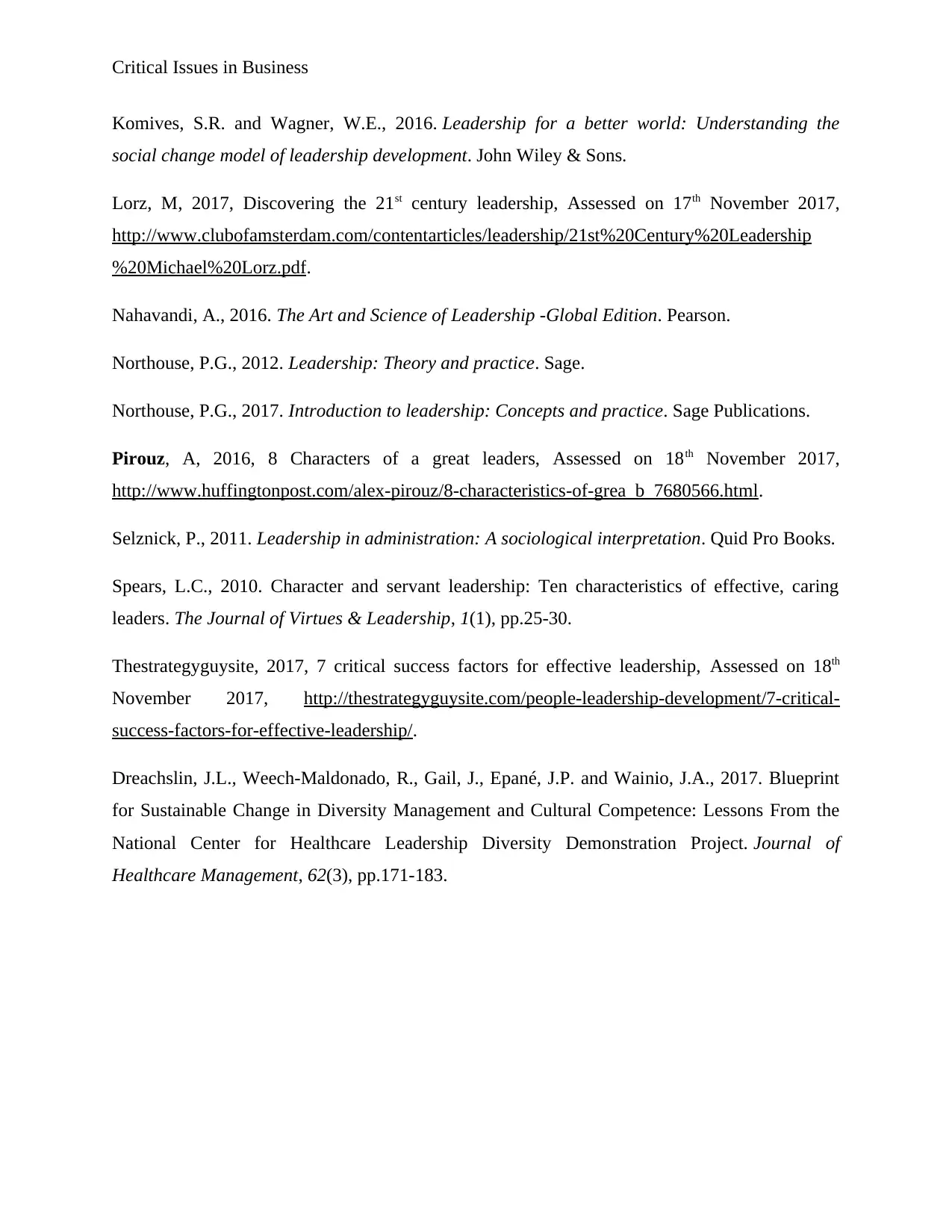
Critical Issues in Business
Komives, S.R. and Wagner, W.E., 2016. Leadership for a better world: Understanding the
social change model of leadership development. John Wiley & Sons.
Lorz, M, 2017, Discovering the 21st century leadership, Assessed on 17th November 2017,
http://www.clubofamsterdam.com/contentarticles/leadership/21st%20Century%20Leadership
%20Michael%20Lorz.pdf.
Nahavandi, A., 2016. The Art and Science of Leadership -Global Edition. Pearson.
Northouse, P.G., 2012. Leadership: Theory and practice. Sage.
Northouse, P.G., 2017. Introduction to leadership: Concepts and practice. Sage Publications.
Pirouz, A, 2016, 8 Characters of a great leaders, Assessed on 18th November 2017,
http://www.huffingtonpost.com/alex-pirouz/8-characteristics-of-grea_b_7680566.html.
Selznick, P., 2011. Leadership in administration: A sociological interpretation. Quid Pro Books.
Spears, L.C., 2010. Character and servant leadership: Ten characteristics of effective, caring
leaders. The Journal of Virtues & Leadership, 1(1), pp.25-30.
Thestrategyguysite, 2017, 7 critical success factors for effective leadership, Assessed on 18th
November 2017, http://thestrategyguysite.com/people-leadership-development/7-critical-
success-factors-for-effective-leadership/.
Dreachslin, J.L., Weech-Maldonado, R., Gail, J., Epané, J.P. and Wainio, J.A., 2017. Blueprint
for Sustainable Change in Diversity Management and Cultural Competence: Lessons From the
National Center for Healthcare Leadership Diversity Demonstration Project. Journal of
Healthcare Management, 62(3), pp.171-183.
Komives, S.R. and Wagner, W.E., 2016. Leadership for a better world: Understanding the
social change model of leadership development. John Wiley & Sons.
Lorz, M, 2017, Discovering the 21st century leadership, Assessed on 17th November 2017,
http://www.clubofamsterdam.com/contentarticles/leadership/21st%20Century%20Leadership
%20Michael%20Lorz.pdf.
Nahavandi, A., 2016. The Art and Science of Leadership -Global Edition. Pearson.
Northouse, P.G., 2012. Leadership: Theory and practice. Sage.
Northouse, P.G., 2017. Introduction to leadership: Concepts and practice. Sage Publications.
Pirouz, A, 2016, 8 Characters of a great leaders, Assessed on 18th November 2017,
http://www.huffingtonpost.com/alex-pirouz/8-characteristics-of-grea_b_7680566.html.
Selznick, P., 2011. Leadership in administration: A sociological interpretation. Quid Pro Books.
Spears, L.C., 2010. Character and servant leadership: Ten characteristics of effective, caring
leaders. The Journal of Virtues & Leadership, 1(1), pp.25-30.
Thestrategyguysite, 2017, 7 critical success factors for effective leadership, Assessed on 18th
November 2017, http://thestrategyguysite.com/people-leadership-development/7-critical-
success-factors-for-effective-leadership/.
Dreachslin, J.L., Weech-Maldonado, R., Gail, J., Epané, J.P. and Wainio, J.A., 2017. Blueprint
for Sustainable Change in Diversity Management and Cultural Competence: Lessons From the
National Center for Healthcare Leadership Diversity Demonstration Project. Journal of
Healthcare Management, 62(3), pp.171-183.
1 out of 11
Related Documents
Your All-in-One AI-Powered Toolkit for Academic Success.
+13062052269
info@desklib.com
Available 24*7 on WhatsApp / Email
![[object Object]](/_next/static/media/star-bottom.7253800d.svg)
Unlock your academic potential
Copyright © 2020–2025 A2Z Services. All Rights Reserved. Developed and managed by ZUCOL.




